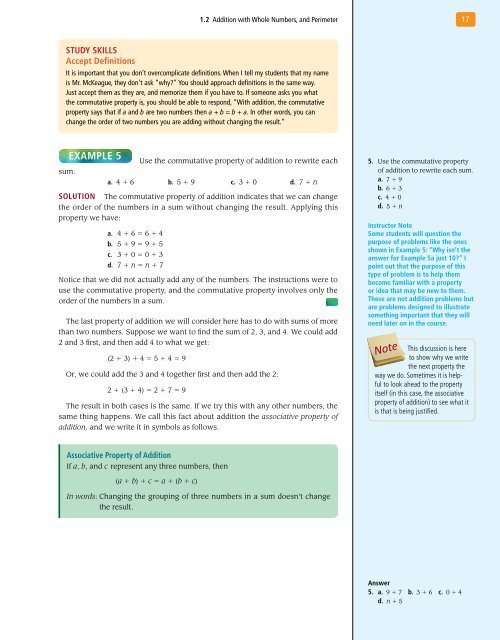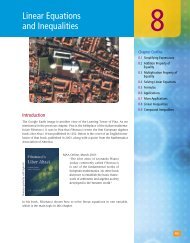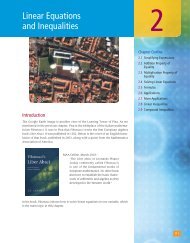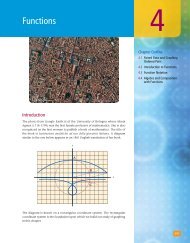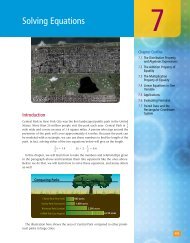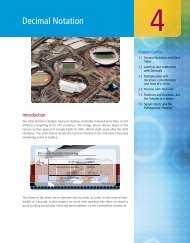Chapter 1 - XYZ Custom Plus
Chapter 1 - XYZ Custom Plus
Chapter 1 - XYZ Custom Plus
You also want an ePaper? Increase the reach of your titles
YUMPU automatically turns print PDFs into web optimized ePapers that Google loves.
1.2 Addition with Whole Numbers, and Perimeter17Study SkillSAccept DefinitionsIt is important that you don’t overcomplicate definitions. When I tell my students that my nameis Mr. McKeague, they don’t ask “why?” You should approach definitions in the same way.Just accept them as they are, and memorize them if you have to. If someone asks you whatthe commutative property is, you should be able to respond, “With addition, the commutativeproperty says that if a and b are two numbers then a + b = b + a. In other words, you canchange the order of two numbers you are adding without changing the result.”Example 5Use the commutative property of addition to rewrite eachsum.a. 4 + 6 b. 5 + 9 c. 3 + 0 d. 7 + nSolution The commutative property of addition indicates that we can changethe order of the numbers in a sum without changing the result. Applying thisproperty we have:a. 4 + 6 = 6 + 4b. 5 + 9 = 9 + 5c. 3 + 0 = 0 + 3d. 7 + n = n + 7Notice that we did not actually add any of the numbers. The instructions were touse the commutative property, and the commutative property involves only theorder of the numbers in a sum.The last property of addition we will consider here has to do with sums of morethan two numbers. Suppose we want to find the sum of 2, 3, and 4. We could add2 and 3 first, and then add 4 to what we get:(2 + 3) + 4 = 5 + 4 = 9Or, we could add the 3 and 4 together first and then add the 2:2 + (3 + 4) = 2 + 7 = 9The result in both cases is the same. If we try this with any other numbers, thesame thing happens. We call this fact about addition the associative property ofaddition, and we write it in symbols as follows.5. Use the commutative propertyof addition to rewrite each sum.a. 7 + 9b. 6 + 3c. 4 + 0d. 5 + nInstructor NoteSome students will question thepurpose of problems like the onesshown in Example 5: “Why isn’t theanswer for Example 5a just 10?” Ipoint out that the purpose of thistype of problem is to help thembecome familiar with a propertyor idea that may be new to them.These are not addition problems butare problems designed to illustratesomething important that they willneed later on in the course.NoteThis discussion is hereto show why we writethe next property theway we do. Sometimes it is helpfulto look ahead to the propertyitself (in this case, the associativeproperty of addition) to see what itis that is being justified.Associative Property of AdditionIf a, b, and c represent any three numbers, then(a + b) + c = a + (b + c)In words: Changing the grouping of three numbers in a sum doesn’t changethe result.Answer5. a. 9 + 7 b. 3 + 6 c. 0 + 4d. n + 5


